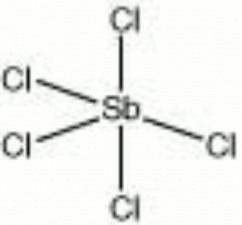Antimony pentachloride
Description
A yellow, oily liquid with a putrid smell. Antimony pentachloride is used as a stain for materials containing hydroxyl groups such as dammar, mastic, sterols, oil nondrying oils, and vitamins. It reacts to form an adduct that fluoresces blue-white in light ultraviolet light. Antimony pentachloride is moisture sensitive and will decompose in the presence of water or alcohols.
Synonyms and Related Terms
APC; antimony perchloride
Other Properties
Soluble in hydrochloric acid, chloroform, carbon tetrachloride. Hydrolyzes in water to form solid Sb2O5.
Maximum absorption wavelength= 430 nm; Maximum emission wavelength= 550 nm.
| Composition | SbCl5 |
|---|---|
| CAS | 7647-18-9 |
| Melting Point | 2.8-3.5 |
| Density | 2.34 |
| Molecular Weight | mol. wt. = 299.02 |
| Boiling Point | 77 (dec) |
Hazards and Safety
Corrosive, fumes in moist air. Reacts strongly with organics.
Highly toxic. Will damage skin and membranes on contact.
Fisher Scientific: MSDS 08/02/00
Additional Information
R. Wolbers, N. Sterman and C. Stavroudis, Notes for Workshop on New Methods in the Cleaning of Paintings,1990, GCI, Los Angeles.
Authority
- Richard S. Lewis, Richard S. Lewis, Hawley's Condensed Chemical Dictionary, Van Nostrand Reinhold, New York, 10th ed., 1993
- Richard C. Wolbers, Nanette T. Sterman, Chris Stavroudis, Richard C. Wolbers, Nanette T. Sterman, Chris Stavroudis, Notes for Workshop on New Methods in the Cleaning of Paintings, J.Paul Getty Trust, Los Angeles, 1990
- The Merck Index, Martha Windholz (ed.), Merck Research Labs, Rahway NJ, 10th edition, 1983 Comment: entry 736
